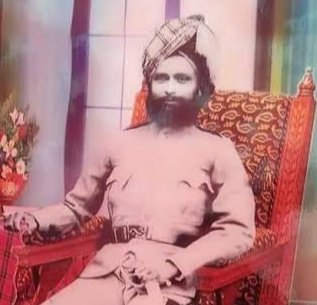•Rajputs in the Jaunpur district• 🧵
The Rajputs, as of 1903, numbered at 101,002 people, or 9.24% of the Hindu population of the Jaunpur district.
Found throughout the districts, divided into various clans, of which the Prominent ones being–
The Rajputs, as of 1903, numbered at 101,002 people, or 9.24% of the Hindu population of the Jaunpur district.
Found throughout the districts, divided into various clans, of which the Prominent ones being–

•The Raghuvanshi Rajputs
Numbered at 16,736 as of 1891. They traditionally descend from the sons of Doman Deo, a Raghuvanshi from Varanasi. They are said to have expelled the aboriginal tribes from Chandwak and also Dobhi– one of the chief settlements of this clan.
Numbered at 16,736 as of 1891. They traditionally descend from the sons of Doman Deo, a Raghuvanshi from Varanasi. They are said to have expelled the aboriginal tribes from Chandwak and also Dobhi– one of the chief settlements of this clan.

•The Bais Rajputs
Numbered at 12,348 people as of 1901. The Bais are distributed all over the district, but are strongest in the Khutahan and Jaunpur tehsils. Their old strongholds were around the Gomti river and one colony is said to be founded by a Bais named Luka Singh.
Numbered at 12,348 people as of 1901. The Bais are distributed all over the district, but are strongest in the Khutahan and Jaunpur tehsils. Their old strongholds were around the Gomti river and one colony is said to be founded by a Bais named Luka Singh.

•The Durgvanshi Rajputs
Numbered at 14,070 people as of 1898. The Durgvanshis are a branch of the Bilkhariyas of Pratapgarh, who in turn are a branch of the Dikhits of Unnao. Their ancestor Durgdev Shah defeated the Bhars, and with time they spread over many parts of Jaunpur.
Numbered at 14,070 people as of 1898. The Durgvanshis are a branch of the Bilkhariyas of Pratapgarh, who in turn are a branch of the Dikhits of Unnao. Their ancestor Durgdev Shah defeated the Bhars, and with time they spread over many parts of Jaunpur.

•The Nanwag/Nandwak Rajputs
Numbered at 9,077 as of 1891. The Nanwags are said to have occupied all of Mariyahu, Barsathi and Gopalpur. Mariyahu was home to many forts of the Nanwags. They are chiefly found in the Mariyahu tehsil.
Numbered at 9,077 as of 1891. The Nanwags are said to have occupied all of Mariyahu, Barsathi and Gopalpur. Mariyahu was home to many forts of the Nanwags. They are chiefly found in the Mariyahu tehsil.

•The Bachgoti Rajputs
Numbered at 4,095 people as of 1901. The Bachgotis of the districts are akin to the families of Sultanpur and Pratapgarh belonging to the same clan. They are chiefly found in the Machhalishahar Tehsil.
Numbered at 4,095 people as of 1901. The Bachgotis of the districts are akin to the families of Sultanpur and Pratapgarh belonging to the same clan. They are chiefly found in the Machhalishahar Tehsil.

•The Rajkumar Rajputs
Numbered at 5,240 people. The Rajkumars are the kinsmen of the Bachgotis. They are more specifically a branch of the Bachgoti clan. They have spread into Jaunpur from the Sultanpur district. They chiefly reside in the Khutahan Tehsil.
Numbered at 5,240 people. The Rajkumars are the kinsmen of the Bachgotis. They are more specifically a branch of the Bachgoti clan. They have spread into Jaunpur from the Sultanpur district. They chiefly reside in the Khutahan Tehsil.

•The Parmar Rajputs
Numbered at 4,089 people. The Parmars are found in all Tehsils and also in surrounding districts.
Numbered at 4,089 people. The Parmars are found in all Tehsils and also in surrounding districts.

•The Chandel Rajputs
Numbered at 4,022 people. The Chandels of this district are said to have migrated from Kanpur and upon their arrival, they are also said to have displaced the Bhars. They are chiefly found in the Mariyahu and Jaunpur tehsils, and they also owned 2 Taluqas.
Numbered at 4,022 people. The Chandels of this district are said to have migrated from Kanpur and upon their arrival, they are also said to have displaced the Bhars. They are chiefly found in the Mariyahu and Jaunpur tehsils, and they also owned 2 Taluqas.

•The Bisen Rajputs
Numbered at 3,287 people as of 1901. The Bisens, like all members of this clan, trace their origins to Majhauli, the ancestral seat of this clan in the Deoria district. They chiefly reside in the Mariyahu tehsil with presence in other tehsils as well.
Numbered at 3,287 people as of 1901. The Bisens, like all members of this clan, trace their origins to Majhauli, the ancestral seat of this clan in the Deoria district. They chiefly reside in the Mariyahu tehsil with presence in other tehsils as well.

Other prominent clans of the District being– the Gautam at 2,410; Gaharwar at 2,323; Chauhan at 1,847; Somvanshi at 1,832 and Nikumbh at 1,573.
Along with these- The Surajbansi, Kachhwaha, Sengar, Solanki, Surwar, Pachotariya, Bhanwag, Maunas and Chaupatkhamb are also present.

Along with these- The Surajbansi, Kachhwaha, Sengar, Solanki, Surwar, Pachotariya, Bhanwag, Maunas and Chaupatkhamb are also present.


@threadreaderapp unroll
• • •
Missing some Tweet in this thread? You can try to
force a refresh











